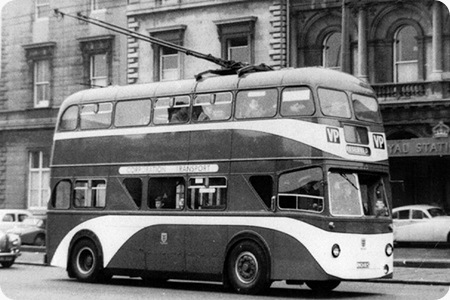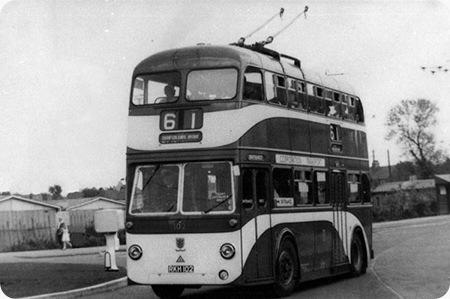Hull Corporation – Sunbeam MF2B – RKH 102/15 – 102/15

Photographs by ‘unknown’ if you took these photos please go to the copyright page.
Kingston upon Hull Corporation Transport
Sunbeam MF2B
1954 (102) 1955 (115)
Roe H30/24D
The final batch of Kingston upon Hull Corporation trolleybuses, comprised a batch of 15 production and one prototype Sunbeam MF2B’s with Roe 54 seat highbridge bodywork. Due to the date of the prototype entering service in 1953, the whole batch were known as "Coronation" They were designed by the General Manager of KHCT, Mr G H Pulfrey, and the bodies were built to his design by Charles H Roe, of Crossgates, Leeds.
They were designed for one man operation, but in fact were never so used. The bodies were of 8′ width and featured front entrances, ahead of the front wheels and a central exit; internally they were fitted with two staircases, and a periscope was fitted to allow the driver to see how may seats were available on the upper deck, without leaving his seat. Another new feature in Hull was the use of automatic trolley retrievers, to assist with rewiring dislodged trolley poles.
It is believed that the 16 "Coronations" were always allocated to Cottingham Road Garage, working the Chanterlands Avenue and Beverley Road routes (61 and 63). Their working lives were comparatively short being only 9 to 11 years. Despite their short lives, none were sold for use elsewhere, but some Motors and electrical equipment were sold to Bradford, the remainder going for scrap. It is a shame that none of these fine vehicles were preserved.
The two photographs show number 102 (RKH 102), working route 61 on Chanterlands Avenue at the Goddard Avenue turning circle, this was the terminus of the 65 short working. It is on the outward journey. The second photograph shows sister vehicle 115 (RKH 115), In Ferensway, Hull city centre, passing the (then) Royal Station Hotel, whilst working a special service. The streamline livery of Hull Corporation, is shown to best effect on these vehicles.
Photograph and Copy contributed by Keith Easton
———
What superb vehicles these Hull trolleybuses were, and to a unique design too. I remember them so well from my RAF days at Patrington (1955/6) and of course they were in their prime then. What a tragedy that, if they had to be withdrawn early, they couldn’t have been sold as complete runners to Bradford. With five or six years remaining for the Bradford system they would have been a fine sight in the lovely blue and cream of the last trolleybus network in the Country – ah well, we can dream.
Chris Youhill
———
Ref the Bradford comment, lets play ‘what if’s’ for a moment!.
If we assume that going from a two door to front door only layout ( i.e. as per Atlantean or Fleetline) would gain 10 seats – 2 x doubles on each deck in place of the stairs + a double in place of the door that would take it up to a 64 seater. Extend the body in the rear overhang by one full bay would gain another row of seats on each deck which now gives us a 72 seat 30 foot bus. Sounds drastic?, perhaps – but not as drastic as building a complete new body which is what Bradford did only two years earlier on the ex Mexborough chassis and even then only finishing up with a vehicle with less seats at greater cost. Perhaps we could then have also seen a One Man Operated trolleybus as originally intended?.
By the way – is it me or does anyone else think that the Coronations bear a strong resemblance to the AEC Q type trolleybus?
Andrew
———
I talked, a month ago, about AEC cul-de-sacs – but often a design is years ahead of itself. Could be this is just such an example.
Sometimes a vehicle morphs into someone else’s.
Daimler Roadliner became:
Dennis Falcon V became:
Duple 425 became:
Dennis R series
The Bristol RE became:
Ward Dalesman GRX and Dennis Falcon H/HC
Did you know, though, that the last Sunbeam motor bus was a Sunbeam Regent – the trolleybus side was sold separately!!!
David Oldfield
———
The decision to abandon Hull’s trolleybus network was made in 1959, but although the trolleybuses were making a healthy profit, passenger numbers were on the decline, as more journeys were being made into the B zone, whilst the trolleybuses were only operating within the A zone. In 1934, the well known co-ordination agreement with East Yorkshire took effect and the tram routes in the B zone were abandoned and replaced by motor buses. Hull could have had a much larger trolleybus network, but for two reasons. The first being the co-ordination agreement, and secondly the cost of extending the overhead equipment. Had the trams not been curtailed, the trolleybuses would almost certainly have operated within the B zone also. This could have also seen EYMS trolleybuses, what a thought!
Keith Easton
———
A wonderful thought indeed Keith – but I imagine no through workings to Beverley as that would have been pushing the clearance miracle under The Bar just too far !!
Chris Youhill
———
Oh, I don’t know, Chris. You remember the principle of the conduit trams in London!
Stephen Ford
———
Indeed Stephen, I remember the London conduit system very well. On frequent childhood holidays in South London I spent many hours wonderment in watching the procedure for changing from overhead to conduit at the south end of Streatham High Road on the A23. Any such trolleybus scheme for the Beverley Bar would, I’m afraid, have been stamped on heavily at the planning stage in that very conservative ancient town.
Chris Youhill
———
With all the hoo-ha over satellite dishes in the Avenues, from the residents association, I very much doubt that trolleybuses would be allowed along Chanterlands Avenue these days; let alone Beverley! Seriously, though, trolleybuses working around Hessle, Anlaby, Willerby and Cottingham would have been serious contenders for, perhaps circular, services to and from Hull.
Keith Easton
———
As an aside, I notice that Hull was another (trolley) bus organisation which did not really consider visitors to the city in terms of blind displays. Enormous numbers and an almost begrudging display of the destination, and this was the ’50’s! Whilst it could be argued that pre-war London Transport intermediate blind displays were over the top, they did at least consider the native and visiting passenger. Smart vehicles, though, and nice to see a general manager ploughing his own furrow.
Chris Hebbron
———
Hello Chris, please see my comments on the AEC Regent III, HAT 471, for an explanation of Hull’s post-war blinds. Pre-war blinds in Hull were really quite informative, giving inner and outer terminals, with the main road(s) traversed, and the route number. For an example see the rear blind on Sunbeam W, number 80 (that will be posted 25/09). I must agree with post-war blinds though, but as a native Hullensian, we knew which route numbers went where, but it was not easy for visitors, but most Hull folk were friendly anyway.
Keith Easton
———
Interesting to read that these vehicles were intended for one-man-operation, given that this was not to be legal on double deckers for another 12/13 years; I would have thought that in 1953 O-M-O was fairly uncommon even on single deckers!
Dave Towers
———
The Coronations were also used on service 62 – I used service 62 every day to go to school. No. 101 did a six week stint on every route when it first entered service although the Hessle Road stay was cut short because it couldn’t cope with the very heavy loads.
The photo of 115 shows in Paragon Square on the DOLRS tour which covered every route and garage. No. 115 was newly repainted. There are other photos which show it in Holderness Road garage and at North Bridge.
Malcolm Wells
———
26/04/12 – 06:17
Keith, I think that RKH 102 is pictured at the end of Chanterlands Avenue, entering the Bricknell Avenue roundabout, just before it reaches Goddard Avenue. In the mid-1950s the roundabout was quite new, prior to which the trolleybuses used to sweep majestically round the bend into Chants North! The site of the pre-fabs in the background is now occupied by sheltered homes and the bus shelter at far right is now the Rainhill Road stop (opposite Murrayfield Road).
Malcolm Burke
Quick links to the - Comments Page - Contact Page - Home Page
Please leave a comment
Please Note if you want to send a photograph with your comment please use the Contact Page by clicking here or send as an attachment via email.

